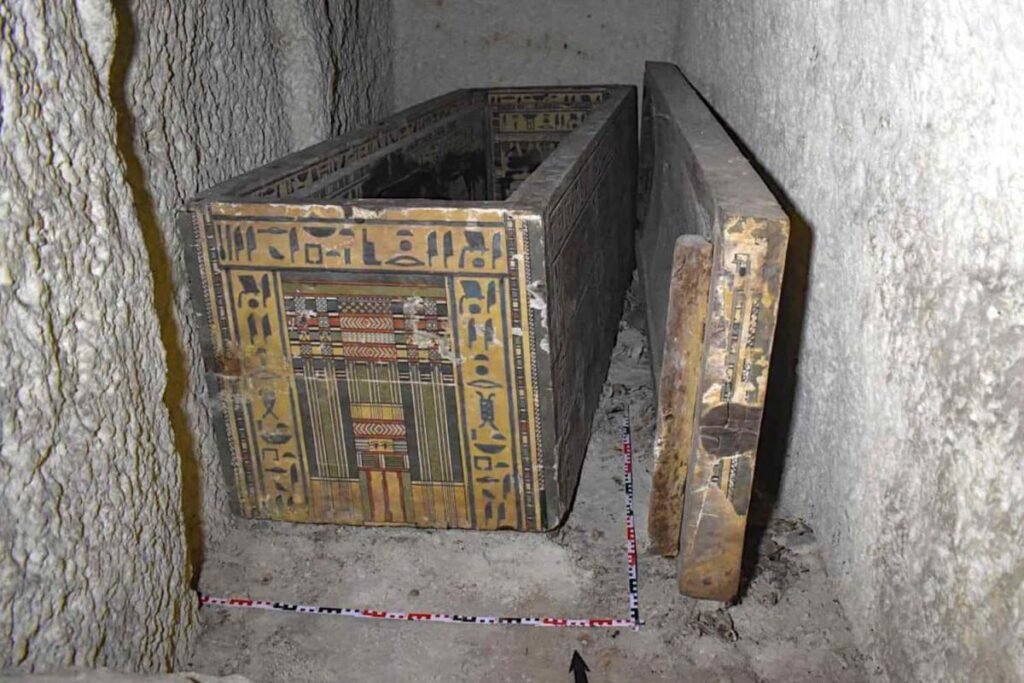The recent discovery of an ancient tomb in Assiut, Egypt, has garnered significant attention, revealing important insights into the life of a high-ranking Egyptian woman named Idi. Found by an Egyptian-German archaeological mission, the tomb dates back over 4,000 years, and its excavation took place in a cemetery located on the Western Mount of Assiut, approximately 240 miles south of Cairo. The Egyptian Ministry of Tourism and Antiquities announced the find on October 2, highlighting that Idi was the daughter of the governor of the Assiut Region during the reign of King Snosert I. Through this discovery, historians have taken a step closer to understanding the status and lives of women in ancient Egypt, particularly during the Middle Kingdom era, which spanned from 2030 to 1640 B.C.
The discovery of Idi’s tomb is particularly remarkable given that it contained two highly decorative coffins—one tucked inside the other—for her burial. This layered coffin arrangement is a rarity, as most tombs from this period are not found in such pristine condition. UCLA Egyptologist Kathlyn Cooney remarked that finding two intact Middle Kingdom coffins is extraordinary. The hieroglyphics adorning the coffins reference Idi as the “lady of the house,” emphasizing her status and significance within her family and society. The burial artifacts give valuable context and shed light on the artistic craftsmanship and funerary practices of that era.
Initial investigations into Idi’s remains suggest she died at a relatively young age—under 40 years old—and had some health complications, including a congenital foot defect. This information points to the challenges she may have faced during her lifetime, which adds a human dimension to her historical significance. The burial site has provided insights into not just her life but also the lives of her contemporaries during the Middle Kingdom, including attitudes toward health and disability. The tomb, discovered deep within the cemetery, also underscores the historical prominence of her family; they were buried in the largest known non-royal cemetery in Egypt at the time.
Further examination of the burial chamber has revealed that it extends roughly 15 meters, or 40 feet, deep, with well-preserved inscriptions that narrate an ancient journey. The two coffins found within it measure 7.5 feet for the smaller and 8.5 feet for the larger coffin, underscoring the importance and grandeur attributed to Idi’s burial. It is noted that despite the integrity of the tomb structure, it had been disturbed in ancient times by thieves, who removed Idi’s mummy. Such incidents highlight the practices of grave robbery in ancient Egypt and prompt reflections on the reverence for the dead and the artifacts that accompanied them in burial.
The ongoing archaeological efforts in Assiut signal a committed dedication to unearthing and understanding Egypt’s rich history. Dr. Mohamed Ismail Khaled, Secretary General of the Egyptian Supreme Council of Antiquities, mentioned the importance of the cleaning and scientific assessment of the remains, as they seek to uncover more about Idi’s life, her father, and the historical context of their time. The potential findings from these examinations may pave the way for a deeper understanding of societal structures, family dynamics, and the role of women in ancient Egyptian civilization.
Minister of Tourism and Antiquities Sharif Fathi has expressed encouragement for the Egyptian archaeological missions, recognizing their critical role in enhancing our grasp of ancient history. He affirmed that the ministry would fully support these endeavors, emphasizing their importance not only for historical scholarship but also for cultural heritage and tourism. As excavation and research continue, the story of Idi, her family, and the broader societal landscape of ancient Egypt is anticipated to unfold, offering richer narratives that connect the past with the present. The discovery signifies a notable contribution to the corpus of knowledge surrounding the Middle Kingdom and will likely inspire further archaeological pursuits in Egypt.

